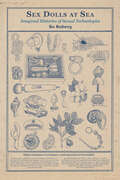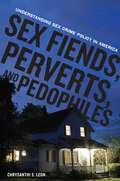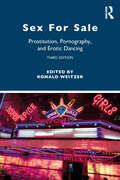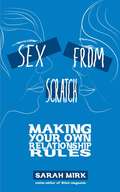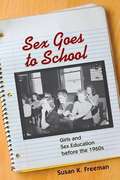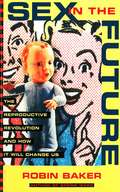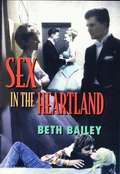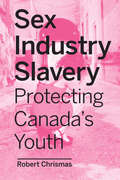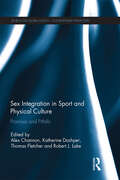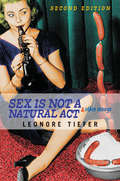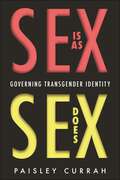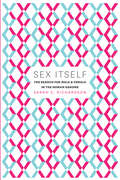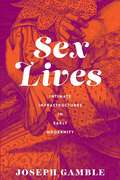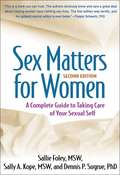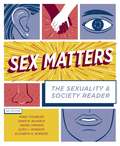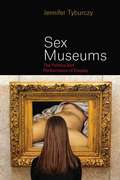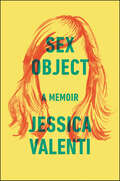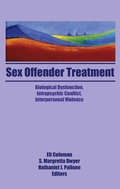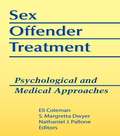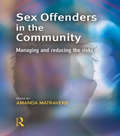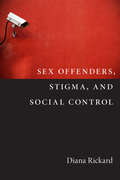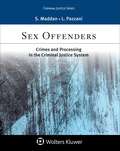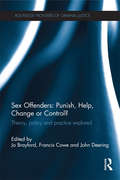- Table View
- List View
Sex Differences in Labor Markets (Routledge Research In Gender And Society Ser. #Vol. 10)
by David NeumarkSex differences abound in labor markets. In the United States three differences in particular have attracted the most attention: the earnings gap, occupational segregation, and the greater responsibility of women for child care and housework, and consequential lower participation in the labor market.This volume brings together David Neumark's work
Sex Dolls at Sea: Imagined Histories of Sexual Technologies (Media Origins)
by Bo RubergInvestigating and reimagining the origin story of the sex doll through the tale of the sailor&’s dames de voyage.The sex doll and its high-tech counterpart the sex robot have gone mainstream, as both the object of consumer desire and the subject of academic study. But sex dolls, and sexual technology in general, are nothing new. Sex dolls have been around for centuries. In Sex Dolls at Sea, Bo Ruberg explores the origin story of the sex doll, investigating its cultural implications and considering who has been marginalized and who has been privileged in the narrative. Ruberg examines the generally accepted story that the first sex dolls were dames de voyage, rudimentary figures made of cloth and leather scraps by European sailors on long, lonely ocean voyages in centuries past. In search of supporting evidence for the lonesome sailor sex doll theory, Ruberg uncovers the real history of the sex doll. The earliest commercial sex dolls were not the dames de voyage but the femmes en caoutchouc: &“women&” made of inflatable vulcanized rubber, beginning in the late nineteenth century. Interrogating the sailor sex doll origin story, Ruberg finds beneath the surface a web of issues relating to gender, sexuality, race, and colonialism. What has been lost in the history of the sex doll and other sex tech, Ruberg tells us, are the stories of the sex workers, women, queer people, and people of color whose lives have been bound up with these technologies.
Sex Fiends, Perverts, and Pedophiles: Understanding Sex Crime Policy in America
by Chrysanthi S. LeonFrom Megan’s Law to Jessica’s Law, almost every state in the nation has passed some law to punish sex offenders. This popular tough-on-crime legislation is often written after highly-publicized cases have made the gruesome rounds through the media, and usually features harsh sentences, lifetime GPS monitoring, a dramatic expansion of the civil commitment procedures, and severe restrictions on where released sex offenders may live. In Sex Fiends, Perverts, and Pedophiles, Chrysanthi Leon argues that, while the singular notion of the sexual boogeyman has been used to justify these harsh policies, not all sex offenders are the same and such ‘one size fits all’ policies can unfairly punish other offenders of lesser crimes, needlessly targeting, sometimes ostracizing, citizens from their own communities.While many recognize that prison is not the right tool for every crime problem, Leon compellingly argues that the U.S. maintains a one-size-fits-all approach to sexual offending which is undermining public safety. Leon explains how we’ve reached this point—with a large incarcerated sex offender population, many of whom will be released in the coming years with multiple barriers to their success in the community, and without much expertise to guide them or to guide those who are charged to help them. Leon argues that we cannot blame the public, nor even the politicians, except indirectly. Instead, we might blame the institutions we charge with making placement decisions and with the experts—both those who have chosen to work in the field and those who have caused its marginalization. Ultimately, Leon shows that when policies intended for the worst offenders take over, all of us suffer.
Sex For Sale: Prostitution, Pornography, and Erotic Dancing
by Ronald WeitzerSince the publication of the second edition in 2010, the field of sex work studies has expanded. This fully updated edition of Sex for Sale: Prostitution, Pornography, and Erotic Dancing presents an innovative, in-depth, and nuanced analysis of sex work, its risks, and benefits, and pays attention to newer and everchanging types of sex work and its actors, as well as public policies and laws that govern its trade. Now in its third edition, this volume includes updated research on traditional forms of sexual labor and incorporates original, empirically grounded research on newer or less researched phenomena. New chapters explore the use of technology among street sellers, blurring the line between street and online solicitation, in addition to chapters on historical prostitution, transgender workers, illicit massage parlors, male strippers, commercial webcamming, alternative policies and legal systems, and the sex workers' rights movement. The combination of cutting-edge and comprehensive analyses and carefully constructed methodologies in Sex for Sale makes it an excellent source of information for scholars and university students in gender studies, sociology, and criminology.
Sex From Scratch
by Sarah MirkModern life calls for modern relationship advice. Sex From Scratch: Making Your Own Relationship Rules is a love and dating guidebook that gleans real-life knowledge from smart people in a variety of nontraditional relationships. Instead of telling people how to snag a man and find "true love," the book sums up what dozens of diverse folks have learned the hard way over time-life advice from people making open relationships work to people who've decided they're never going to have kids-that is helpful to anyone, in any type of relationship. This is an essential, fun, insightful resource whose time has come.
Sex Goes to School: Girls and Sex Education before the 1960s
by Susan K. FreemanWhen seeking approaches for sex education, few look to the past for guidance. But Susan K. Freeman's investigation of the classrooms of the 1940s and 1950s offers numerous insights into the potential for sex education to address adolescent challenges, particularly for girls. From rural Toms River, New Jersey, to urban San Diego and many places in between, the use of discussion-based classes fostered an environment that focused less on strictly biological matters of human reproduction and more on the social dimensions of the gendered and sexual worlds that the students inhabited. Although the classes reinforced normative heterosexual gender roles that could prove repressive, the discussion-based approach also emphasized a potentially liberating sense of personal choice and responsibility in young women's relationship decisions. In addition to the biological and psychological underpinnings of normative sexuality, teachers presented girls' sex lives and gendered behavior as critical to the success of American families and, by extension, the entire way of life of American democracy. The approaches of teachers and students were sometimes predictable and other times surprising, yet almost wholly without controversy in the two decades before the so-called Sexual Revolution of the 1960s. Sex Goes to School illuminates the tensions between and among adults and youth attempting to make sense of sex in a society that was then, as much as today, both sex-phobic and sex-saturated.
Sex In The Future: The Reproductive Revolution and How it Will Change Us
by Robin BakerProvocative and often shocking, Sex in the Future examines how advances in reproductive technology will change human behavior. In-vitro fertilization and surrogate motherhood could mean the end not only of infertility but also of the need for men and women to form relationships or for women to interrupt careers for pregnancy. Sperm and egg storage mean people can literally shop for genes, while cloning, egg-egg fertilization, and other techniques will lead to fertility on demand in a Reproduction Restaurant. What will all our choices be, and how far down this road do we want to travel?
Sex In the Heartland
by Beth BaileySex in the Heartland is the story of the sexual revolution in a small university town in the quintessential heartland state of Kansas. Bypassing the oft-told tales of radicals and revolutionaries on either coast, Beth Bailey argues that the revolution was forged in towns and cities alike, as "ordinary" people struggled over the boundaries of public and private sexual behavior in postwar America.
Sex Industry Slavery in Present-Day Canada
by Robert ChrismasSexual exploitation and human sex trafficking is a multi-billion-dollar international industry that preys on youth. Written by veteran police officer Robert Chrismas, Sex Industry Slavery is an impactful read for anyone who wants to know more about this serious Canadian problem. Many young women are coerced into oppressive relationships in the sex industry, often starting in childhood. There are numerous barriers and challenges for children who are vulnerable to exploitation as well as for survivors striving to leave the sex industry; however, there are also many opportunities to help them. Based on Chrismas’s award-winning research in Manitoba, this book includes gut-wrenching stories from survivors, social workers, police officers, lawmakers, and activists. Representing decades of collective knowledge, Sex Industry Slavery presents first-hand perspectives on the problem as well as proposes practical solutions.
Sex Integration in Sport and Physical Culture: Promises and Pitfalls (Sport in the Global Society – Contemporary Perspectives)
by Alex Channon Robert J. Lake Thomas Fletcher Katherine DashperScholars working in the academic field of sport studies have long debated the relationship between sport and gender. Modern sport forms, along with many related activities, have been shown to have historically supported ideals of male superiority, by largely excluding women and/or celebrating only men’s athletic achievements. While the growth of women’s sport throughout the 20th and 21st centuries has extinguished the notion of female frailty, revealing that women can embody athletic qualities previously thought exclusive to men, the continuation of sex segregation in many settings has left something of a discursive ‘back door’ through which ideals of male athletic superiority can escape unscathed, retaining their influence over wider cultural belief systems. However, sex-integrated sport potentially offers a radical departure from such beliefs, as it challenges us to reject assumptions of male superiority, entertaining very different visions of sex difference and gender relations to those typically constructed through traditional models of physical culture. This comprehensive collection offers a diverse range of international case studies that reaffirm the contemporary relevance of sex integration debates, and also articulate the possibility of sport acting as a legitimate space for political struggle, resistance and change.This book was originally published as a special issue of Sport in Society.
Sex Is Not A Natural Act & Other Essays: And Other Essays (Psychology, Gender, And Theory Ser.)
by Leonore TieferRevisits and updates the centrality of the social construction of sexuality, especially in the age of Viagra, FSD (female sexual dysfunction) and the media saturation of sex. Leonore Tiefer is one of the foremost sexologists working in the United States today; she is a well-known and respected scholar who writes engagingly and humorously about a wide array of topics in sexuality to appeal to both students and general readers. Revised and updated with new pieces on the medicalization of sex, FSD (female sexual dysfunction) and the politics of sex, as well as classic pieces found in the original edition, such as "Am I Normal?: The Question of Sex."
Sex Is as Sex Does: Governing Transgender Identity
by Paisley CurrahWinner, Sexuality and Politics Book Award - American Political Science AssociationFinalist, PROSE Award - Government and PoliticsWhat the evolving fight for transgender rights reveals about government power, regulations, and the lawEvery government agency in the United States, from Homeland Security to Departments of Motor Vehicles, has the authority to make its own rules for sex classification. Many transgender people find themselves in the bizarre situation of having different sex classifications on different documents. Whether you can change your legal sex to “F” or “M” (or more recently “X”) depends on what state you live in, what jurisdiction you were born in, and what government agency you’re dealing with. In Sex Is as Sex Does, noted transgender advocate and scholar Paisley Currah explores this deeply flawed system, showing why it fails transgender and non-binary people. Providing examples from different states, government agencies, and court cases, Currah explains how transgender people struggle to navigate this confusing and contradictory web of legal rules, definitions, and classifications. Unlike most gender scholars, who are concerned with what the concepts of sex and gender really mean, Currah is more interested in what the category of “sex” does for governments. What does “sex” do on our driver’s licenses, in how we play sports, in how we access health care, or in the bathroom we use? Why do prisons have very different rules than social service agencies? Why is there such resistance to people changing their sex designation? Or to dropping it from identity documents altogether? In this thought-provoking and original volume, Sex Is as Sex Does reveals the hidden logics that have governed sex classification policies in the United States and shows what the regulation of transgender identity can tell us about society’s approach to sex and gender writ large.Ultimately, Currah demonstrates that, because the difficulties transgender people face are not just the result of transphobia but also stem from larger injustices, an identity-based transgender rights movement will not, by itself, be up to the task of resolving them.
Sex Itself: The Search for Male and Female in the Human Genome
by Sarah S. RichardsonHuman genomes are 99. 9 percent identicalOCowith one prominent exception. Instead of a matching pair of X chromosomes, men carry a single X, coupled with a tiny chromosome called the Y. aTracking the emergence of a new and distinctive way of thinking about sex represented by the unalterable, simple, and visually compelling binary of the X and Y chromosomes, "Sex Itself" examines the interaction between cultural gender norms and genetic theories of sex from the beginning of the twentieth century to the present, postgenomic age. aaaaaaaaaaaUsing methods from history, philosophy, and gender studies of science, Sarah S. Richardson uncovers how gender has helped to shape the research practices, questions asked, theories and models, and descriptive language used in sex chromosome research. From the earliest theories of chromosomal sex determination, to the mid-century hypothesis of the aggressive XYY supermale, to the debate about Y chromosome degeneration, to the recent claim that male and female genomes are more different than those of humans and chimpanzees, Richardson shows how cultural gender conceptions influence the genetic science of sex. aaaaaaaaaaaaRichardson shows how sexual science of the past continues to resonate, in ways both subtle and explicit, in contemporary research on the genetics of sex and gender. With the completion of the Human Genome Project, genes and chromosomes are moving to the center of the biology of sex. "Sex Itself" offers a compelling argument for the importance of ongoing critical dialogue on how cultural conceptions of gender operate within the science of sex. "
Sex Lives: Intimate Infrastructures in Early Modernity
by Joseph GambleIn Sex Lives, Joseph Gamble draws from literature, art, and personal testimonies from sixteenth- and seventeenth-century Europe to uncover how early moderns learned to have sex. In the early modern period, Gamble contends, everyone from pornographers to Shakespeare recognized that sex requires knowledge of both logistics (how to do it) and affect (how to feel about it). And knowledge, of course, takes practice.Gamble turns to a wide range of early modern texts and images from England, France, and Italy, ranging from personal accounts to closet dramas to visual art in order to excavate and analyze a variety of sexual practices in early modernity. Using an intersectional, phenomenological approach to bring historical light to the quotidian sexual experiences of early modern subjects, the book develops the critical concept of the “sex life”—a colloquialism that opens up methodological avenues for understanding daily lived experience in granular detail, both in the distant past and today. Through this lens, Gamble explores how sex organized and permeated everyday life and experiences of gender and race in early modernity. He shows how affects around sex structure the plays of Shakespeare and his contemporaries, revealing the role of sexual feeling and sexual racism in early modern English drama.Sex Lives reshapes how we understand Renaissance literature, the history of sexuality, and the meaning of sex in both early modern Europe and our own moment.
Sex Matters for Women, Second Edition
by Sally A. Kope Sallie FoleySex is talked about more openly today than ever before, but if you still struggle with sexual myths, self-doubt, and "embarrassing" questions, you're in good company. Now in a fully updated second edition, this trusted guide has already helped many thousands of women understand how their bodies work and take charge of their sexuality. The authors are experienced therapists who interweave candid reflections from diverse women with current, science-based information, exercises, and advice. You'll find answers to everything from how to have more satisfying sex to questions about body image, anatomy, hormones, relationships, sexual orientation, sexually transmitted infections, and trauma. Sexuality is a lifelong journey--this book gives you a roadmap for self-discovery and growth.
Sex Matters: The Sexuality and Society Reader
by Wendy Simonds Mindy Stombler Dawn M. Baunach Elroi J. Windsor Elisabeth O. BurgessSex Matters: The Sexuality and Society Reader has a strong sociological focus and a sex-positive perspective. With 38 new readings, Sex Matters covers a wide and diverse range of sexual experiences and identities and tackles controversial issues in a straightforward, nonstigmatizing manner. The editors mix qualitative and quantitative empirical pieces, sexual narratives and personalized accounts, cutting-edge research, and articles from the popular press for a wealth of content and diverse perspectives.
Sex Museums
by Jennifer TyburczyAll museums are sex museums. In Sex Museums, Jennifer Tyburczy takes a hard look at the formation of Western sexuality--particularly how categories of sexual normalcy and perversity are formed--and asks what role museums have played in using display as a technique for disciplining sexuality. Most museum exhibits, she argues, assume that white, patriarchal heterosexuality and traditional structures of intimacy, gender, and race represent national sexual culture for their visitors. Sex Museums illuminates the history of such heteronormativity at most museums and proposes alternative approaches for the future of public display projects, while also offering the reader curatorial tactics--what she calls queer curatorship--for exhibiting diverse sexualities in the twenty-first century. Tyburczy shows museums to be sites of culture-war theatrics, where dramatic civic struggles over how sex relates to public space, genealogies of taste and beauty, and performances of sexual identity are staged. Delving into the history of erotic artifacts, she analyzes how museums have historically approached the collection and display of the material culture of sex, which poses complex moral, political, and logistical dilemmas for the Western museum. Sex Museums unpacks the history of the museum and its intersections with the history of sexuality to argue that the Western museum context--from its inception to the present--marks a pivotal site in the construction of modern sexual subjectivity.
Sex Object: A Memoir
by Jessica ValentiNew York Times Bestseller - An NPR Best Book of the Year“Sharp and prescient… The appeal of Valenti’s memoir lies in her ability to trace objectification through her own life, and to trace what was for a long time her own obliviousness to it…Sex Object is an antidote to the fun and flirty feminism of selfies and self-help.” — New RepublicAuthor and Guardian US columnist Jessica Valenti has been leading the national conversation on gender and politics for over a decade. Now, in a darkly funny and bracing memoir, Valenti explores the toll that sexism takes from the every day to the existential. Sex Object explores the painful, funny, embarrassing, and sometimes illegal moments that shaped Valenti’s adolescence and young adulthood in New York City, revealing a much shakier inner life than the confident persona she has cultivated as one of the most recognizable feminists of her generation. In the tradition of writers like Joan Didion and Mary Karr, this literary memoir is sure to shock those already familiar with Valenti’s work and enthrall those who are just finding it.
Sex Offender Treatment: Accomplishments, Challenges and Future Directions
by Edmond J Coleman Michael MinerExamine the major advances in sexual offender treatment over the last decade and promising new concepts in treatment, supervision, and research Sex Offender Treatment: Accomplishments, Challenges, and Future Directions points the way toward humane, dignified, effective treatment regimes for sexual offenders. In addition to providing an essential overview of the current state of sex offender treatment, this book examines vital areas of service provision and research and points to future directions for the field. On the medical/psychological front, this volume explores the importance of recognizing comorbid psychiatric factors in treatment and of exploring central nervous system function's role as a cause of sexually inappropriate behavior. In the legislative/justice arena it illustrates a "Circles of Support" proposal that mobilizes community resources to aid the adjustment of released offenders rather than branding them as dangerous to the community. And in the area of service provision, this book presents a treatment approach for residential programs that is inspired by research on childhood behavioral problems and special education. This book will increase your effectiveness with: a model of multisystemic treatment for juvenile sex offenders a restorative justice approach for reintegrating adult offenders into the community a study of the physical/mental correlates of organic brain dysfunction a case report on the use of a pharmaceutical treatment (leuprolide acetate) for pedophiles
Sex Offender Treatment: Biological Dysfunction, Intrapsychic Conflict, Interpersonal Violence
by Edmond J Coleman Margretta DwyerSex Offender Treatment: Biological Dysfunction, Intrapsychic Conflict, Interpersonal Violence assists sex therapists, counselors, psychiatrists, and psychologists working in sex offender treatment in providing more effective services. You’ll gain timely knowledge of sex offending behavior and treatment approaches that will stimulate your thinking and help you improve your research and treatment methodologies. From Sex Offender Treatment, you’ll acquire valuable insight and a cross-cultural viewpoint as you explore chapters written by international scholars who have set the standards of care for sex offender treatment. Contributors aim to improve the effectiveness of sex offender treatment throughout the world by challenging you to conduct more research that will provide a better understanding of sex offenders and improve treatment approaches. Authors presented their contributions at the Third International Congress on the Treatment of Sex Offenders held in Minneapolis, Minnesota. The book begins with a Standards of Care for the Treatment of Sex Offenders. This guides you in increasing the effectiveness of the treatment you provide to sex offenders. The Standards of Care helps you analyze new data and gain a basis for successful sex offender treatment. Following chapters probe into the nature of interpersonal violence and aggression and a further understanding of pedophilia and exhibitionism. You will begin to more thoroughly understand sex offending behavior as you read about: motives contributing to sexual aggression and the confluence model of sexual aggression the background and clinical characteristics of paraphilic individuals and sex offenders a case study of sex offenders, victims, and their families the “abuse to abuser hypothesis” in regard to pedaphilia assessment, psychosexual profiling, and treatment of exhibitionist behavior the treatment of sex offenders with mental retardation the relationship between sex offender treatment success and learning difficulties incest offender perceptions of treatment as used to generate an explanatory theory of the sexual abuse treatment process.Chapters in Sex Offender Treatment emphasize the importance of good assessment techniques, issues affecting victims and families of sex offenders, why treatment does not work for some sex offenders, medical problems associated with sex offenders, and working with special populations of sex offenders. Counselors, researchers, educators, sex offender treatment personnel, forensic psychologists and psychiatrists, and sex therapists will find Sex Offender Treatment crucial for gaining insight into sex offenders’motives and behaviors. You can then use these perspectives to more effectively interact with sex offenders and to more accurately analyze sex offending behavior.
Sex Offender Treatment: Psychological and Medical Approaches
by Edmond J Coleman Margretta DwyerThis important volume brings together findings in the psychological and medical treatment of sex offenders. It disseminates research from experts around the world in the field of sex offender treatment, making this knowledge available to researchers and clinicians everywhere. Professionals struggling to find effective methods for treating their patients will find Sex Offender Treatment a valuable tool for their daily work.Chapters in Sex Offender Treatment cover a variety of topics. Authors examine such areas as psychodynamic and psychiatric disorders associated with the sex offender, findings on pharmacologic interventions, treatment techniques and the public perception of sex offender treatment, and cautionary notes for those who provide therapy for sex offenders. Within these areas, some specific themes addressed include: types of personality disorders and implications for more effective treatment the effectiveness of antiandrogen treatment and the promising results of other pharmacotherapies techniques for developing insight in incest perpetrators a study of adult male incest offenders’perceptions of the treatment process an adolescent treatment program using a family communication approach hypotheses regarding sexual offenders and men who batter, using psychodynamic and feminist theoryFull of practical strategies and useful information, Sex Offender Treatment is a book professionals will reach for again and again.
Sex Offenders in the Community: Managing And Reducing The Risks (Cambridge Criminal Justice Series)
by Amanda MatraversThis book explores current criminal justice responses to the management of individuals who are convicted of sexual offences. It aims to help policy-makers, practitioners and students to develop an informed position on this complex and increasingly controversial issue. Although the focus is primarily upon the UK context, contributions from North America (USA and Canada) provide an important comparative perspective.
Sex Offenders, Stigma, and Social Control
by Diana RickardThe 1990s witnessed a flurry of legislative initiatives--most notably, "Megan's Law"--designed to control a population of sex offenders (child abusers) widely reviled as sick, evil, and incurable. In Sex Offenders, Stigma, and Social Control, Diana Rickard provides the reader with an in-depth view of six such men, exploring how they manage to cope with their highly stigmatized role as social outcasts. The six men discussed in the book are typical convicted sex offenders--neither serial pedophiles nor individuals convicted of the type of brutal act that looms large in public perceptions about sex crimes. Sex Offenders, Stigma, and Social Control explores how these individuals, who have been cast as social pariahs, construct their sense of self. How does being labeled in this way and controlled by measures such as Megan's Law affect one's identity and sense of social being? Unlike traditional criminological and psychological studies of this population, this book frames their experiences in concepts of both deviance and identity, asking how men so highly stigmatized cope with the most extreme form of social marginality. Placing their stories within the context of the current culture of mass incarceration and zero-tolerance, Rickard provides a deeper understanding of the complex relationship between public policy and lived experience, as well as an understanding of the social challenges faced by this population, whose re-integration into society is far from simple or assured. Sex Offenders, Stigma, and Social Control makes a significant contribution to our understanding of sex offenders, offering a unique window into how individuals make meaning out of their experiences and present a viable--not monstrous--social self to themselves and others.
Sex Offenders: Crimes and Processing in the Criminal Justice System (Criminal Justice Series)
by Sean Maddan; Lynn PazzaniThis book is about sex offenders. Whereas most books will focus on either sex crimes or sexual deviance, this book examines the entire etiology of sex crimes. This includes discussions of the nature of sex crimes, sexual deviance, and, maybe most importantly, the processing of sex offenders through the criminal justice system. This includes sex offender interactions with law enforcement, the courts, and corrections. Corrections for sex offenders encompasses a myriad of programs: prison, sex offender registration and notification, civil commitments, residence restrictions, and treatment. One unique aspect of this book is its focus on criminal justice system’s treatment of sex offenders, given scant if any coverage in other books. The book also emphasizes two of the most common sex crimes, rape and sex offenses against children, and addresses the impact of sex crimes on victims. In sum, this book offers a comprehensive approach to the study of sex offenders.
Sex Offenders: Theory, Policy and Practice Explored (Routledge Frontiers of Criminal Justice)
by Jo Brayford John Deering Francis CoweSex offending, and in particular child sex offending, is a complex area for policy makers, theorists and practitioners. A focus on punishment has reinforced sex offending as a problem that is essentially ‘other’ to society and discourages engagement with the real scale and scope of sexual offending in the UK. This book looks at the growth of work with sex offenders, questioning assumptions about the range and types of such offenders and what effective responses to these might be. Divided into four sections, this book sets out the growth of a broad legislative context and the emergence of child sexual offenders in criminal justice policy and practice. It goes on to consider a range of offences and victim typologies arguing that work with offenders and victims is complex and can provide a rich source of theoretical and practical knowledge that should be utilised more fully by both policy makers and practitioners. It includes work on female sex offenders, electronic monitoring and animal abuse as well as exploring interventions with sex offenders in three different contexts; prisons, communities and hostels. Bringing together academic, practice and policy experts, the book argues that a clear but complex theoretical and policy approach is required if the risk of re- offending and further victimisation is to be reduced. Ultimately, this book questions whether it makes sense to locate responsibility for responding to sexual offending solely within the criminal justice domain.

